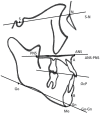The relationship between craniofacial development and hypodontia in patients with Down syndrome
- PMID: 26275771
- PMCID: PMC4914765
- DOI: 10.1093/ejo/cjv054
The relationship between craniofacial development and hypodontia in patients with Down syndrome
Abstract
Background/objective: Hypodontia is often seen in people with Down syndrome (DS). In the normal population, persons with hypodontia have a shorter cranial base and a hypoplastic maxilla, leading to a skeletal Class III tendency and a reduced face height. The purpose of this study was to examine craniofacial morphology in patients with DS at different ages and the influence of hypodontia on their craniofacial morphology.
Materials and methods: A comparative cross-sectional study was conducted in 63 children with DS (6-19 years old; 28 males and 35 females) at a Centre for Special Care Dentistry in Rotterdam, the Netherlands (CBT Rijnmond). Digital lateral cephalograms were obtained from all subjects and a cephalometric analysis was performed. The subjects were divided into a group with hypodontia (13 males and 25 females) and a group without hypodontia (15 males and 10 females).
Results: Significant results included a decrease in antero-posterior relationship of upper and lower jaw (ANB angle -0.331° per year, P = 0.044) and a decrease in vertical dimension (S-N_Go-Gn angle -0.72° per year, P = 0.039) over the years in subjects with hypodontia compared to subjects without hypodontia.
Conclusion: The process of growth in DS patients is towards a reversed overjet. Hypodontia seems to have an additional effect on this development. The management of hypodontia as part of the complete treatment of dental development in DS children is important because it strongly influences the jaw relationship.
© The Author 2015. Published by Oxford University Press on behalf of the European Orthodontic Society. All rights reserved. For permissions, please email: journals.permissions@oup.com.
Figures
References
-
- Bouvy-Berends E.C. and Reuland-Bosma W (2006) ‘Emily goes to the dentist’. Oral care for individuals with Down syndrome. Nederlands Tijdschrift Voor Tandheelkunde, 113, 234–238. - PubMed
-
- Seagriff-Curtin P. Pugliese S. and Romer M (2006) Dental considerations for individuals with Down syndrome. The New York State Dental Journal, 72, 33–35. - PubMed
-
- Musich D.R. (2006) Orthodontic intervention and patients with Down syndrome. The Angle Orthodontist, 76, 734–735. - PubMed
-
- Weijerman M.E. van Furth A.M. Vonk Noordegraaf A. van Wouwe J.P. Broers C.J. and Gemke R.J (2008) Prevalence, neonatal characteristics, and first-year mortality of Down syndrome: a national study. The Journal of Pediatrics, 152, 15–19. - PubMed
-
- Barden H.S. (1983) Growth and development of selected hard tissues in Down syndrome: a review. Human Biology, 55, 539–576. - PubMed
Publication types
MeSH terms
LinkOut - more resources
Full Text Sources
Other Literature Sources
Medical


